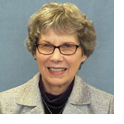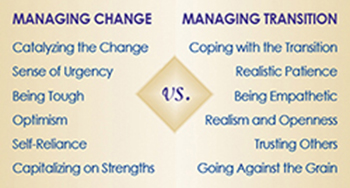
Balancing Change and Transition
With another academic year under way—and an abundance of new leaders and initiatives—UW is again moving from one organizational reality to the next. Research shows that effective leaders manage change on the structural level while also guiding people through the interpersonal behaviors that accompany transition. By striking the right balance between the two, leaders build and reinforce the trust that is essential to incorporating change and moving forward.
Kerry Bunker and Michael Wakefield have worked with more than two thousand leaders in the Center for Creative Leadership’s weeklong Leading People Through Transition training program and co-authored Leading With Authenticity in Times of Transition. This book shows how leaders can gauge and adjust their behavior to maintain the crucial balance between the business or organizational side of leading change and the human side of leading transition.
Opposing Competencies
Bunker and Wakefield have identified twelve competencies that leaders need when things are in flux. The competencies are combined into six pairs, with one of each pair supporting leading the change and the other supporting leading through transition. There are inherent conflicts and paradoxes between each pair; the leader who is a successful and trusted change agent demonstrates ongoing attention to the situation at hand and the agility to shift emphasis from one competency to its opposite as needed.

The point of stability can be different depending on the situation and the timing. If you picture the balancing pole of a tightrope walker, each end of the pole is crucial. At times, the pole will be held level, and, at others, it might tip slightly in one direction or dramatically dip in another; sometimes the pole must be tilted to maintain balance. Such is the case with opposing competencies. Any of the competencies can be overdone, underdone, or held in a positive dynamic balance with its opposite. Leaders who neglect or devote an overabundance of energy to any one competency run the risk of creating strain on their employees and on the trust employees have placed in them—and, as a consequence, attempted organizational changes may fail or flounder before the end of the tightrope has been reached.
A Particularly Prickly Pair
Let’s look at one pair of opposing competencies that may be especially important for UW leaders to master: capitalizing on strengths versus going against the grain. These opposing competencies are particularly tricky to balance because they put old versus new in stark relief. The payoff, however, is substantial. By finding the appropriate balance between this pair, leaders will foster the ability to learn, and openness to new ideas will be balanced with respect for experience and expertise.
When leaders capitalize on strengths, they know their strengths and attributes, and confidently apply them to tackle new situations and circumstances. They trust the abilities that have generated success for them in the past and use them in new situations. However, relying too much on strengths can lead to failure to recognize conditions that demand different capacities and new learning, creating barriers to responding effectively to the new organizational reality. Sometimes it is necessary to challenge preferred patterns to learn and try new things—to go against the grain.
Leaders who focus on capitalizing on strengths while ignoring the going-against-the-grain competency tend to create organizations that are averse to risks and not very resilient in times of change. Often, they sacrifice the long-term for the short-term and resist new opportunities while maintaining the status quo.
When leaders go against the grain, they are willing to get out of their comfort zone and tolerate discomfort if it leads to learning, which in turn can lead to greater organizational agility, resilience, and flexibility. However, when leaders neglect capitalizing on strengths while overcommitting to going against the grain, there is not enough stability in the environment. These people are often described as loose cannons. They seem to be indiscriminate in their change efforts, discarding the good along with the bad. Employees feel fearful and at risk because their strengths and history are not valued.
Striking a Balance
Bunker and Wakefield suggest achieving balance between capitalizing on strengths and going against the grain by taking the following actions.
- Pay attention to your patterns. What are your key strengths? How applicable are they to your emerging environment? Which are most likely to become obsolete? What are your flaws or weaknesses? What new strengths will you need in the changing environment?
- Leverage your strengths intentionally, rather than defaulting to them. Is your approach or response really the best way or simply a habit?
- Avoid complacency. Provide stretch assignments for yourself and team members. With too little stretch, people won’t be pushed to go against the grain; with too much, they will seek comfort and confidence by reverting to prior strengths.
- Value learning. Honor established practices but seek out improvement in processes. Reward managers for developing others and supporting continuous learning. You want to demonstrate that the ability to learn is a core competency and that new strengths will always be required in a changing world.
- Learn from failure. Create an environment where it is safe to debrief failures as well as successes. Focus more on understanding the learning strategy and thought processes behind actions than the outcomes.
- Don’t limit yourself or others. Seek out diversity, but be careful not to pigeonhole yourself or others. Encourage group members to challenge and defend opposing points of view and take stands on major decisions.
- Encourage new thinking. Reward those who are willing to put time and energy into exploring novel solutions. Question people respectfully to understand all aspects of their ideas. Are there concepts or perspectives that may shed new light on the current reality?
Overcoming Obstacles
One of our greatest obstacles in effectively responding to and managing change is that situations are fluid and what’s needed changes rapidly. The tightrope walker may be caught off-guard by a leg cramp or a gust of wind. Here at the UW, leaders’ own circumstances and their organizations’ circumstances can both determine which of the competencies may need more or less emphasis. Bunker and Wakefield’s model is meant to be dynamic; it works only when leaders periodically assess themselves and their organizations and respond accordingly.
- To help leaders achieve the right balance in their present situation, current functioning and situational requirements can be plotted on Bunker and Wakefield’s Transitional Leadership Wheel, available at www.ccl.org/wheel (click the wheel graphic to access a PDF).
- Leaders should also seek feedback from others in their organization and compare it to their own assessment to get an accurate view. This could be done through conversations with employees at various levels or, more formally, through a 360-degree assessment.
Another obstacle to effectively managing change is the sheer force of habit. The tendency to overdo or underdo a given competency is often linked to leaders’ individual personality characteristics, interpersonal needs and values, or prior learning experiences. Therefore, it’s essential for leaders to be aware of the “baggage” they bring to the decisions they make, look for patterns, and continually assess their effectiveness.
Organizations have habits, too; whether leaders are conscious of it or not, their organizational culture may influence the emphasis they give to each competency. It can be extremely challenging for leaders to behave in ways that are in conflict with the prevailing cultural norms, but it’s imperative. If your culture rewards leadership behavior in a manner that fosters chronic imbalance, for example, and you succumb to that style, you may thrive in the short-term while in the long-term compromising your potential as a leader and your unit’s place in the new organizational reality.
To overcome personal and organizational habits, leaders should consider:
- What are the subtle ways that your organizational cultures operates to influence leader behavior?
- Can you see ways in which your organizational culture influences your leadership style?
- Can you see yourself passing some of those influences along to those who look to you for leadership?
Bunker and Wakefield’s book is an invaluable guide for navigating change and transition. However, even without reading the full text, by remembering the tightrope walker—who succeeds by being vigilant, by continually assessing the situation at hand, and by responding with minor and major adjustments accordingly—leaders can better balance the structural side of leading change and the human side of leading transition.


